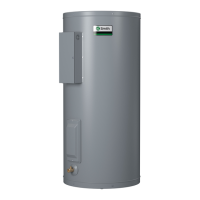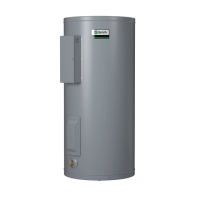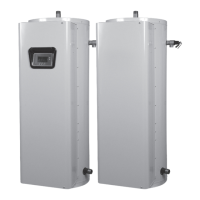If the lower heang element (or, more
rarely, the lower thermostat) is not
working, you will have some hot water
but not as much as before. Because the
lower element does most of the work,
the lower element usually wears out
before the upper element. Replace the
lower element and/or thermostat if
necessary (see page 25-27).
If the water temperature is too hot:
• Install or adjust the Thermostac
Mixing Valves (see manufacturer’s
instrucons), or
• Adjust the thermostat(s) on the water
heater (see Step 10 in the Installaon
secon of this manual).
A nonfunconing thermostat or a
shorted heang element can cause
extremely hot water. If the Temperature
and Pressure Relief Valve (T&P Valve)
releases large amounts of very hot
water, it is likely due to a shorted
heang element, or more rarely a
nonfunconing thermostat, or the
thermostat does not t snuggly against
the tank. Very high water temperatures
can also cause the Energy Cut O (ECO)
to trip (see page 22). Turn power o
unl this problem is xed.
Check both the cold and hot water at a
sink to determine if the lower pressure
is only on the hot water side. If both
hot and cold faucets have low pressure,
call your local water ulity. If the low
pressure is only on the hot water side,
the primary causes of this are:
• Melted heat traps or dip tube.
Soldering copper pipes while they are
connected to the water heater can
melt the heat traps inside the hot and
cold water connecons or the dip tube
(cold water side). Melted heat traps or
a melted dip tube can restrict the ow
of hot water. If that’s the case, replace
the heat traps or dip tube.
• Parally closed supply valve. Open
the water heater’s supply valve fully.
A small amount of water dripping from
the Temperature and Pressure (T&P)
Relief Valve usually means the water
pressure is too high or you need a
properly sized and pressurized Thermal
Expansion Tank. Refer to Step 1 in the
Installaon secon of this manual for
more informaon. A large amount
of hot water coming from the T&P
discharge pipe may be due to the tank
overheang.
High water
pressure can cause the T&P Relief Valve
to drip. Install a Pressure Reducing
Valve (PRV) on the main cold water
supply line. Adjust the PRV to between
50-60 psi (345-414 kPa).
Install a
Thermal Expansion Tank. If a Thermal
Expansion Tank is already installed and
the T&P Relief Valve discharge pipe
drips, the Thermal Expansion Tank may
be pressurized to the wrong pressure or
the internal bladder may be defecve.
Refer to the instrucons that came with
the Thermal Expansion Tank for more
informaon.
In rare cases, debris can sck
inside the T&P Relief Valve prevenng
the valve from seang fully. In that case,
the T&P Relief Valve discharge pipe will
drip. You may be able to clear debris
from the T&P Relief Valve by manually
operang the valve, allowing small
quanes of water to ush out the
debris. See the label on the T&P Relief
Valve for instrucons.
If the water pressure is between
50-60 psi (345-414 kPa), a Thermal
Expansion Tank is installed and properly
pressurized, and the valve has been
cleared of any debris, and it sll drips,
the valve may be broken—have a
qualied person replace the T&P relief
valve.
Harmless bacteria normally present
in tap water can mulply in water
heaters and give o a “roen egg”
smell. Although eliminang the bacteria
that causes “smelly water” with a
Chlorinaon system is the only sure
treatment, in some cases, the standard
anode rod that came with your water
heater can be replaced with a special
zinc anode rod which may help reduce
or eliminate the odor. Contact a
qualied person.
To protect the tank, an anode
rod must be installed in the water
heater at all mes or the warranty is
void.
In cases where the “roen egg” smell
is pronounced, you can raise the tank
temperature to 140°F (60°C) in order to
reduce bacteria growth in the tank.
Commercial Electric Water Heater Use and Care Guide • 23
TROUBLESHOOTING

